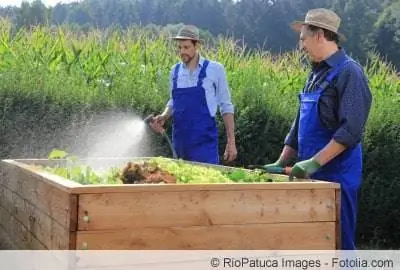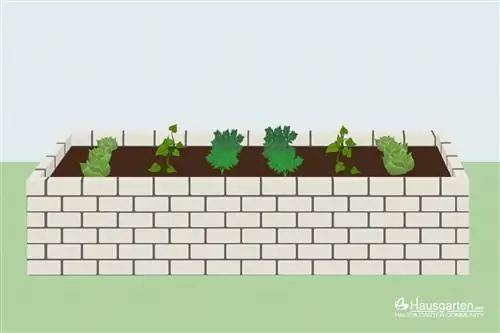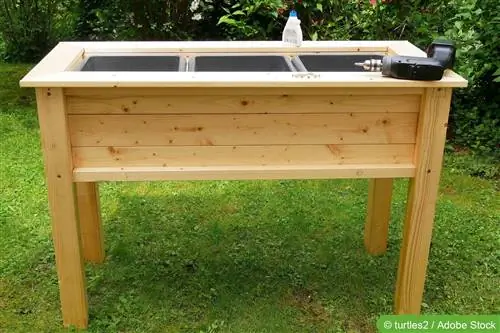- Author admin [email protected].
- Public 2023-12-17 03:39.
- Last modified 2025-01-24 12:45.
The cost of a finished raised bed can be between 100 and 700 euros, depending on the material and design. Not everyone wants or can spend so much money on it. No problem, there are a few ways to build a raised bed yourself cheaply. To do this, you need to know what parts a raised bed consists of and how it works. Many old or leftover building materials can easily be installed in a raised bed, thereby reducing the purchase costs enormously.
Building a raised bed
A raised bed differs from a flat bed in the garden not only in its height, which is around one meter, but also in its internal structure. In a raised bed it almost looks like a compost heap in various stages of ripeness.
- Base: close-meshed wire mesh, slightly curved on the sides (protects against voles)
- above: about a quarter of chopped branches or small-cut twigs from bushes (ensures good ventilation and therefore better rotting)
- Lawn sod or green garden waste, grass clippings and straw (prevent the fine soil from trickling through)
- about a quarter of normal garden soil or potting soil (doesn't have to be particularly high quality)
- ripe, fine-crumb compost (approx. 20 cm filling height)
- fill with fine, high-quality potting or vegetable soil
A raised bed consists of these components
Once you know what components a raised bed is made of, you will surely find alternatives that you can get cheaply or even for free. With a bit of luck, the raised bed will cost next to nothing because it is made from recycled parts that would otherwise have been thrown away.
- A raised bed is usually sunk about 30 cm deep into the ground
- If the side panels should be around one meter high, 130 cm high side panels must be used
- alternatively, if it is well secured, it can also be placed on the floor
- Only very stable materials may be used as side parts (high pressure from the inside)
- the thinner the side parts, the better they need to be stabilized
- With a length of two meters, wooden slats must be at least two centimeters thick
- Stabilization at the corners using squared timber or corner pieces
For comparison (costs for a conventional raised bed made of wooden boards)
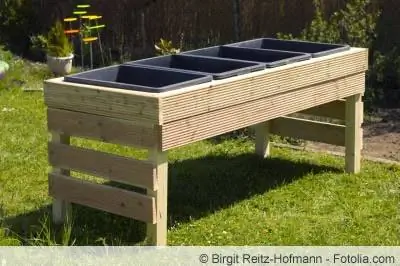
Normally, stable, long-lasting raised beds are built from weather-resistant wooden boards (such as larch). The following costs apply for the kit of a bed:
Bed dimensions approximately:
- Height: approx. 120 centimeters (including 30 cm in the ground)
- Width: approx. 80 centimeters
- Length: approx. 150 centimeters
Requires:
- 6 wooden posts 1200 mm long, 4 pieces for the corners and 2 for stabilizing the long sides, (square 90 x 90 x 2400 mm): 3 pieces, 15 euros each
- Wooden planks for side cladding (21 x 190 x 2400 mm) 12 pieces: about 100 euros
- Wood screws and nails: about 15 euros
- Rabbit wire (with PVC coating) at least 2 running meters: 5 euros
- Film for lining the side parts inside (foundation wall protection bubble film 0.5 x 20 m): 15 euros
Total costs without painting and assembly: 180 euros
Tip:
Corner pieces and sides can of course also be made of plastic or metal. Wood is usually cheaper, but it doesn't last as long in the weather.
Considerations before building your own
If you want to build a raised bed yourself, you should have a little craftsmanship. You also need a few tools that are available in the household or can be borrowed free of charge (from friends or relatives). If the tool has to be rented or even bought for money, it can be quite expensive.
- Wooden construction: cordless screwdriver (or screwdriver), saw for the wooden boards, side cutters (pliers), spirit level, hammer
- Stone construction: bucket and mortar trowel, spirit level, side cutters for the grid, spirit level
Using old building materials is cheaper than buying new
A raised bed can be really cheap if old building materials are available that can be used for construction. These can come from a conversion, demolition, renovation or possibly from a recycling center. In principle, all materials that are weather-resistant and can withstand the high loads generated by the earth inside are suitable.
- Pavement slabs
- Bricks or sand-lime blocks
- Pallets
- old boards
Cheap option made from pallets (size about 80 x 160 cm)

Pallets (disposable pallets) are generated as waste in many companies. With a little skill and patience, they can be picked up free of charge from companies in industrial areas or even grocery stores. This means that companies do not have to dispose of the pallets. Pallets should be completely lined with foil on the inside so that the filling material does not fall out. Disposable pallets can, for example, be bought in a specialist wood store.
- Rabbit fence (wire mesh with PVC jacket) approx. 2-3 running meters: about 6 euros
- Disposable pallets (80 x 120 cm), 6 pieces: maximum 60 euros
- Edging wire (for fastening the pallets inside): 2 euros
- Screws and small parts: about 5 euros
- Foil (large garbage bags are cheaper than pond liner): 2 euros
Total costs with purchased pallets: maximum 75 euros
Alternatively, the pallets can be placed on the long side. In this case, the raised bed has a size of 120 x 120 cm and a height of 80 cm. The price is reduced to around 55 euros.
Tip:
Euro pallets are a little more expensive, but they are also much more stable and last longer.
Repurposed wooden composter
Kits for wooden composters are often available very cheaply in hardware stores. A wooden composter measuring 100 x 100 x 70 can be purchased for just 15 euros. It is therefore slightly lower than a normal raised bed and is not embedded in the ground. Overall, the total costs are as follows:
- Rabbit wire, about 2 running meters: 5 euros
- Composter kit: 15 euros
- Foil (garbage bags): 2 euros
Total costs: 22 euros
Building a raised bed
A very stable raised bed that will last almost indefinitely can be made from bricks or paving slabs. This alternative is particularly cheap if the stones do not have to be purchased individually and no foundation is necessary. When building a raised bed, foundations must always be poured if the raised bed is to be built on a slope or if the subsoil has very little load-bearing capacity (is sandy or softens when wet). Otherwise, the investment is limited to the mortar and sand with which the stones are attached to one another.
Calculation of necessary materials:
- Stone dimensions (example): 11.3 x 11.5 x 24.0 cm
- per square meter: about 19 stones necessary
- per square meter: about 19 liters of mortar
Costs for a brick raised bed with a height of 100 cm, width 150 cm and depth 80 cm (4.6 m²)
The area should be marked out in advance using a stick and a guide line. This means that the height can be oriented using the string and it is not necessary to align every stone with a spirit level. If the area is uneven, it must first be leveled and, if necessary, firmed up a little. Grass or lawn must also be removed before building walls. For the wall you need:
- 33 stones per square meter x 4, 6=151 pieces
- 19 l mortar per square meter x 4, 6=87 l finished mortar
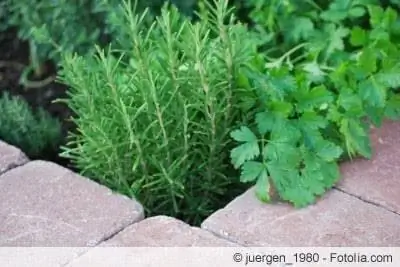
Mortar usually consists of one part lime mortar (from the hardware store), three parts sand and half a part water. For small quantities, it can be mixed in portions in an old 25 liter paint bucket.
- (e.g. sand-lime bricks, 151 pieces)
- 25 kg lime mortar: 3 euros
- 70 kg sand: approx. 8 euros
- close-meshed wire: approx. 5 euros
Total costs: 16 euros
Tip:
Even if the stones have to be purchased, this alternative is still significantly cheaper than the wooden version. The stones are available from building materials stores or hardware stores for around 80 euros.
Conclusion
If you have a little craftsmanship, you can build a raised bed yourself cheaply. Old building materials can easily be used for this project, such as paving slabs, bricks or leftover boards. If no building materials are available, a cost-effective variant with four disposable wooden pallets is possible (maximum 55 euros). Brick raised beds are also not as expensive as you might think: around 150 bricks and mortar only cost around 90 euros. The almost cheapest way to build a raised bed is to buy a simple composter from the hardware store. This can be purchased for as little as 15 euros and converted into a raised bed for less than 10 euros.

